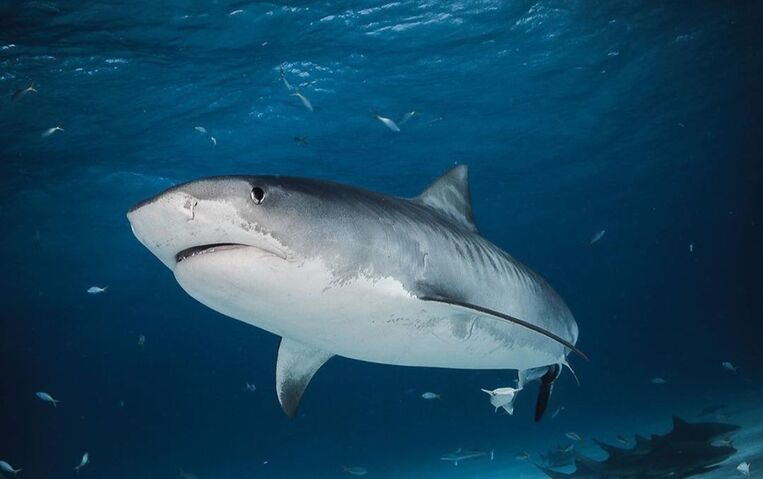Sharks in the Adriatic Sea are a normal and not bad phenomenon in the water. Sharks very rarely attack humans. We know it's not very pleasant when you feel something touch you while swimming in the sea, but maybe some facts in this text will calm you down. Since records exist, in 150 years, sharks in the Adriatic have been responsible for the deaths of 11 swimmers. The last shark attack was recorded in 2008 in a bay on island Vis. Although the Slovenian diver claimed to have been attacked by a great white shark, this has never been proved.
Sharks in the Adriatic Sea
This information will surely surprise you, but don't be scared right away: as many as 54 species of sharks live in the Adriatic. Blue shark (Prionace glauca), Common thresher(Alopias vulpinus), Small-spotted catshark(lat. Scyliorhinus canicula, Starry smoothhound (Mustelus asterias), Spiny dogfish(Squalus acanthias) and Shortfin mako shark(Isurus oxyrinchus) are the most common.
Those huge white sharks that people are very afraid of, are almost non-existent. It is not common to see them in the Mediterranean sea and even less in the Adriatic sea. In fact, only 12 specimens of this shark have been recorded so far in Croatia.
These are the species you can most often encounter while enjoying the Adriatic sea:
Those huge white sharks that people are very afraid of, are almost non-existent. It is not common to see them in the Mediterranean sea and even less in the Adriatic sea. In fact, only 12 specimens of this shark have been recorded so far in Croatia.
These are the species you can most often encounter while enjoying the Adriatic sea:
Common thresher(Alopias vulpinus)
This animal has a very strong and spindle-shaped body. Her snout is short and conical, and small eyes are barely visible on her head. There are 5 gill openings on each side.
It is characterized by a very long upper arm of the fin and a rounded dorsal fin.
Its belly is white and on the back can be grey blue, navy blue, brown or even black.
It has a maximum of 6 meters, and males are smaller than females.
Common thresher feeds on smaller fish, cephalopods and crabs. It often moves along the coast, lives up to some 350 meters depth, but is not dangerous to humans at all.
Common thresher is a common species in Croatia and is often found among the catch.
It is characterized by a very long upper arm of the fin and a rounded dorsal fin.
Its belly is white and on the back can be grey blue, navy blue, brown or even black.
It has a maximum of 6 meters, and males are smaller than females.
Common thresher feeds on smaller fish, cephalopods and crabs. It often moves along the coast, lives up to some 350 meters depth, but is not dangerous to humans at all.
Common thresher is a common species in Croatia and is often found among the catch.
Blue shark (Prionace glauca)
This is the most famous and widespread species of great sharks in Croatia, most of them are in the southern part of the Adriatic because they like warm seas.
This beauty has a slender and spindle-shaped body 4 meters long and a long snout. His back is blue-green or blue, and he has a high and rounded dorsal fin. You can recognize it by the tail fin that is pointed at the tips, and then at the beginning it has one indentation.
It lives along the surface of the sea and does not move deeper than 150 metres. It rarely approaches the coast, and most often hunts at night.
It feeds on fish and cephalopods. This is a species that can be dangerous for swimmers!
This beauty has a slender and spindle-shaped body 4 meters long and a long snout. His back is blue-green or blue, and he has a high and rounded dorsal fin. You can recognize it by the tail fin that is pointed at the tips, and then at the beginning it has one indentation.
It lives along the surface of the sea and does not move deeper than 150 metres. It rarely approaches the coast, and most often hunts at night.
It feeds on fish and cephalopods. This is a species that can be dangerous for swimmers!
Shortfin mako shark(Isurus oxyrinchus)
This shark can grow up to 4 metres, but most often have about 2.5 metres (males are always slightly larger than females). It has a pointed snout and large round eyes. Its dorsal fin is long, and its tail fin is moon-shaped, which is somehow the most recognizable for sharks.
Shortfin mako shark swims both along the coast and on the open sea, up to some 150 meters deep. It is very fast and agile, especially when it is feeding on fish, cephalopods and turtles.
This species has attacked man several times, but does not occur in the Adriatic as often as the other listed species.
Shortfin mako shark swims both along the coast and on the open sea, up to some 150 meters deep. It is very fast and agile, especially when it is feeding on fish, cephalopods and turtles.
This species has attacked man several times, but does not occur in the Adriatic as often as the other listed species.
Spiny dogfish(Squalus acanthias)
This is a small shark that grows to only 120 cm, it is very common in the Adriatic (mostly in the north and middle part). It has a triangular snout that is narrow and long. It has a thorn on the front of its dorsal fins. You will recognize it by its gray back with small white spots.
It likes to live on the bottom of the sea and does not like to swim towards the surface at all. It ranges in depth from 20 to 200 meters, and adores muddy bottoms.
It feeds on fish and crabs, people are not on the meal list.
It likes to live on the bottom of the sea and does not like to swim towards the surface at all. It ranges in depth from 20 to 200 meters, and adores muddy bottoms.
It feeds on fish and crabs, people are not on the meal list.
Small-spotted catshark
This animal is even smaller than Spiny dogfish, it grows up to one metre. You will recognize it by a wide flattened head and oval horizontal eyes. The back and fins are grey, greyish-yellow, brown or blackish.
Small-spotted catshark loves life at the bottom of the sea, but does not go deeper than 200 metres. At the bottom mostly eats crabs, smaller fish and cephalopods.
It is everywhere in the Adriatic and is not dangerous at all.
Small-spotted catshark loves life at the bottom of the sea, but does not go deeper than 200 metres. At the bottom mostly eats crabs, smaller fish and cephalopods.
It is everywhere in the Adriatic and is not dangerous at all.
Interesting facts about sharks
Do you know why sharks have a specific body shape?
So that I can be fast when swimming actively. They are narrow and elongated, and move by means of a strong tail in which most of the muscle is located.
Do you know why feeding them looks so scary?
Because they don't use their teeth to chew, but to tear their prey. The prey is then only swallowed in large chunks.
How are their senses?
Fantastic.
The sense of smell is extremely well developed. Thanks to scented sachets, sharks can "smell" and react to a drop of blood in seawater, in a concentration of 1: 1,000,000.
Most sharks have their eyes set on the side of their head, so their field of vision is extremely large.
So that I can be fast when swimming actively. They are narrow and elongated, and move by means of a strong tail in which most of the muscle is located.
Do you know why feeding them looks so scary?
Because they don't use their teeth to chew, but to tear their prey. The prey is then only swallowed in large chunks.
How are their senses?
Fantastic.
The sense of smell is extremely well developed. Thanks to scented sachets, sharks can "smell" and react to a drop of blood in seawater, in a concentration of 1: 1,000,000.
Most sharks have their eyes set on the side of their head, so their field of vision is extremely large.











